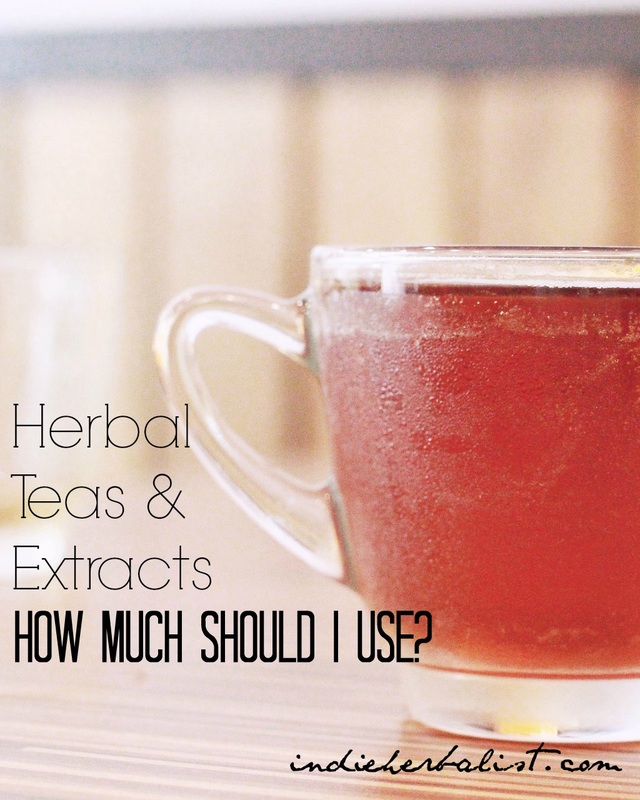Links contained in this post and elsewhere on my website may include affiliate links. When you make a purchase through these links, I earn a commission at no additional cost to you. I only link to products and services that I love - and that I think you will love, too!
Determining how much of an herb to use is somewhat of an art, but it’s also fairly straightforward, especially for acute and first aid uses. If you are using an herbal supplement you purchased from the store, go ahead and follow the serving sizes and directions printed on the product label. If you are more into the DIY side of things and make your own herbal goodies at home, here are some guidelines you can follow that will help you work out the details on your own with some help from a good herbal reference book.
Common Measurements
Most of the time, herbs are measured in drops for liquid extracts and cups for teas. Capsules are another popular choice, but I don’t cover them here because, although empty capsules can be filled at home, they have to be manufactured elsewhere. They are also fiddly to make, and there’s even some debate among herbalists as to their efficacy when compared to a tea or tincture (both of the latter are “pre-digested” in a sense, because the good stuff has been extracted and your digestive system doesn’t have to break down the plant material to get to it).
Extracts, on the other hand, can be made at home from start to finish with homemade fruit-based alcohol or apple cider vinegar. Vodka is another excellent extract medium, and vodka-based extracts can last upwards of ten years- so they are a great option for the long-term herbal wellness cabinet, too. Herbal teas can be bought in bulk, or grown at home from seed to harvest, so we will look at those as well.
Be Aware of Low-Dose Botanicals
To determine how much of an herb to give, first determine whether or not it is considered safe for normal use or if it is a low-dose botanical. A low-dose botanical is an herb that has a traditional record of use in small quantities, but may or may not be considered safe according to modern research. Lobelia is one example. It is potentially toxic and can induce vomiting in large doses, but in small doses was traditionally used as a lung tonic for asthma.
And when we say small doses, we’re talking a few drops of extract or a teaspoon of an infusion. Dosing guidelines for normal herbs range from 15-60 drops per serving of extract or one 8oz serving of tea. In contrast, the dose for lobelia traditionally started at 5 drops.
This is where it is important to have several good books on hand when you are becoming acquainted with a new herb, and it also pays to look up the herb in a more historical work as well. At least one of your reference books should be written by a fairly technical herbalist who likes to go into nitty-gritty details such as dosage rather than simply leaving it to be implied. One excellent resource for this is Medical Herbalism by David Hoffman.
Serving Size by Body Weight
As stated above, most herbal extracts are given in 15-60 drop quantities. This is usually assuming a body weight of 150 lbs (Tierra, 2003), or one to two drops per ten lbs of body weight. One drop per ten lbs is a good place to start for children, and it can be increased to two if needed.
It’s been my experience that homemade extracts can have higher levels of sediment than store bought ones, so I’m not really a fan of storing my extracts with dropper top bottles. I use screw on caps but keep clean droppers stored separately- the droppers are convenient, just not when they clog repeatedly. Which they will do, especially on homemade extracts you don’t use everyday.
But you can do away with the dropper tops entirely, and stick with a quarter-teaspoon measuring spoon. 1/4 teaspoon of extract equals roughly 30 drops. By adding the extract to a small amount of water and dividing the water in half, you will have approximately 15 drops, and in half again will yield about seven.
Teas are just as straightforward as extracts. One cup (8oz) of tea is enough for one serving for a person weighing approximately 150 pounds. Since there are 16 tablespoons in a cup, estimate one tablespoon of tea for every ten pounds of body weight, and adjust upward as needed
Frequency
Frequency of use is another consideration. If you are dealing with an acute imbalance that comes on suddenly and has only been experienced for a short time, and know that the herb you are planning to use falls under the category of normal use and is not a low-dose botanical, the herb can be taken every hour as needed for a day or two. If the imbalance is chronic- something that has been around for months or years- it is generally best to use the herbs two or three times a day, and expect that they will need to be continued long term. A good guideline to follow that’s used by many herbalists is to allow for one month of healing time for every year the chronic problem has been an issue. For herbs that you plan to use more than a few days, double check safety guidelines for long-term use.
Safety Skills
Understanding how to calculate serving size by estimating body weight, knowing how many “drops” equal a teaspoon, and how many tablespoons are in an 8 oz serving of tea may seem confusing at first, but they are important technical skills to have. Once you’ve practiced a little while they become second nature. Herbs are wonderful allies and can help us support our health, but we should approach the topic of serving size with respect and awareness so that we can use herbs safely and with confidence.
All the Best,
Agatha
Resources
Tierra, Lesley, L.Ac., Herbalist, A.H.G. (2003) Healing with the Herbs of Life. Berkeley: Crossing Press.
Learn Herbalism with my Favorite Resources!*
*I earn a commission on sales made through links provided in this article and on indieherbalist.com. These commissions help me keep writing awesome articles for you! Thanks for your support!


